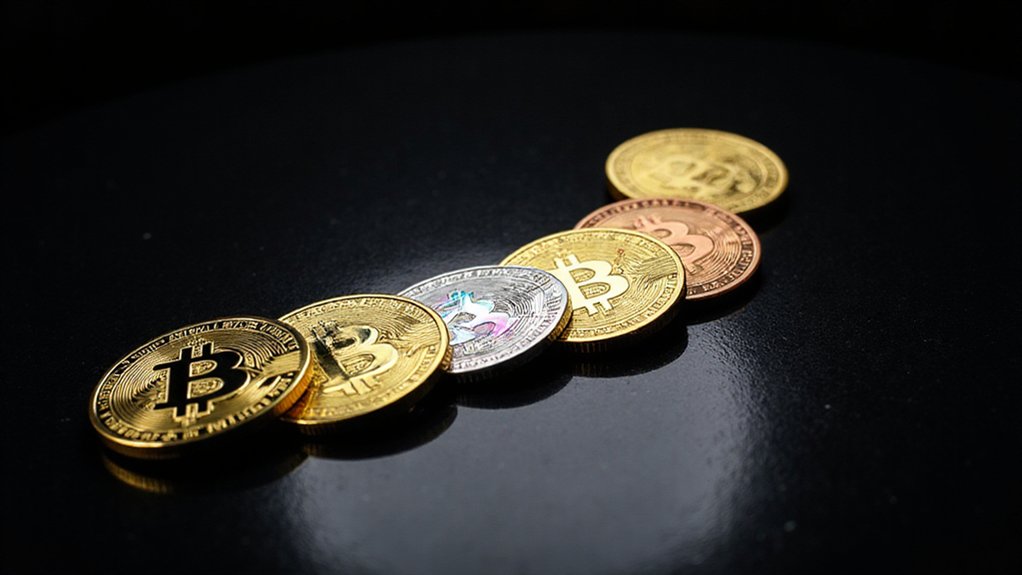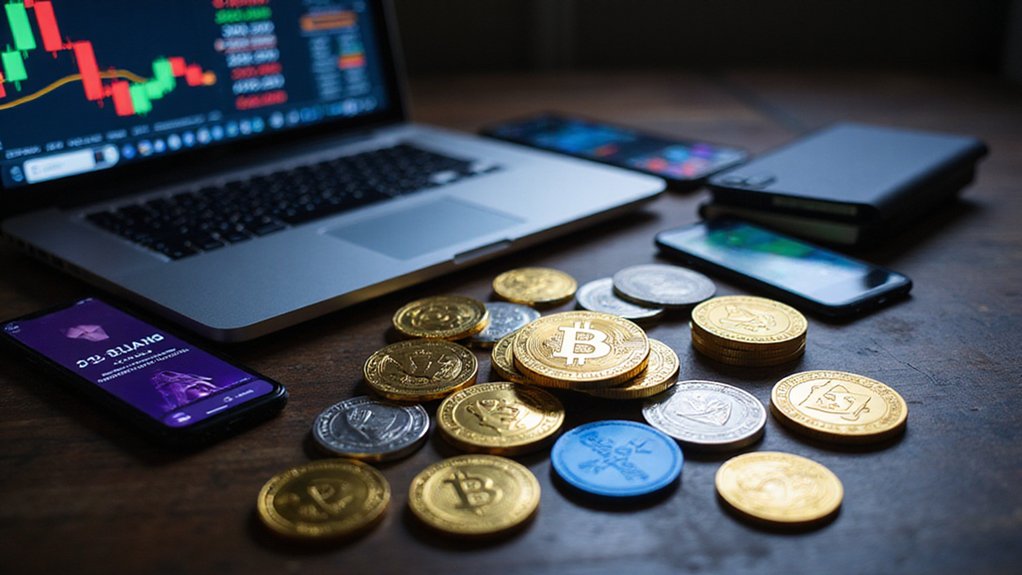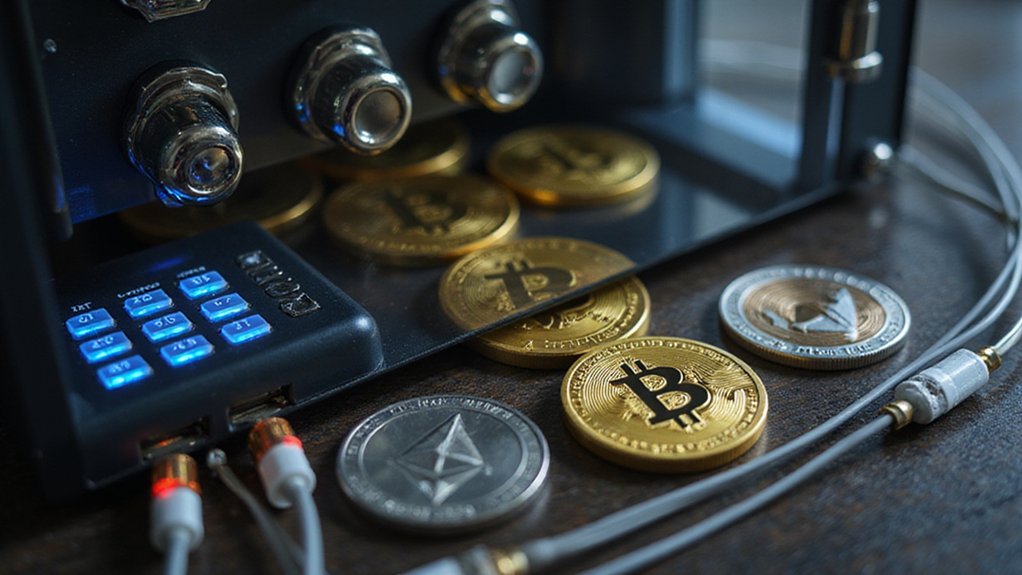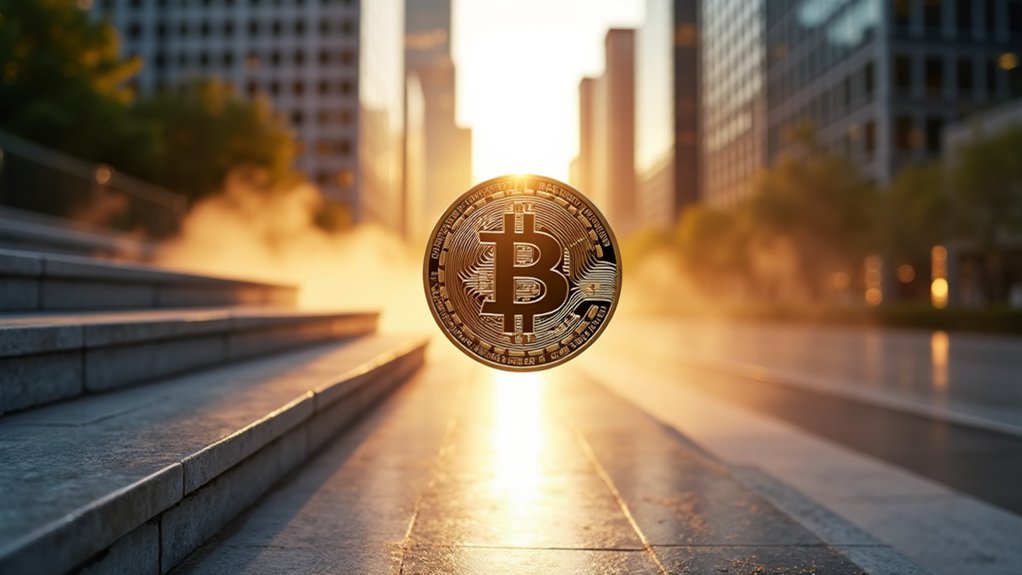Ethereum remains the institutional darling through its Proof of Stake upgrade and DeFi dominance, while Solana’s high-throughput architecture continues attracting gaming applications despite occasional network hiccups. Binance Coin benefits from its exchange ecosystem’s relentless expansion, and Cardano’s methodical, research-driven approach finally shows tangible progress. Ripple’s XRP demonstrates surprising regulatory resilience, maintaining banking partnerships that seemed impossible during legal uncertainties. These established players navigate 2024’s maturing landscape where utility increasingly trumps speculation, though the deeper mechanics reveal fascinating strategic positioning worth exploring further.

The cryptocurrency landscape of 2024 presents a curious paradox: while Bitcoin continues its relentless march toward institutional legitimacy, the altcoin ecosystem has matured into something resembling actual utility rather than pure speculation (though one could argue the distinction remains delightfully blurry).
Ethereum’s shift to Proof of Stake through Ethereum 2.0 represents perhaps the most consequential blockchain upgrade in recent memory, addressing energy concerns while maintaining its stranglehold on the DeFi and NFT ecosystems.
The network’s developer community continues building innovative applications with the methodical persistence of ants constructing a particularly complex anthill—one that happens to process billions in daily transactions.
Binance Coin benefits from what economists might call “ecosystem momentum,” deriving value from Binance’s trading dominance and the surprisingly robust Binance Smart Chain.
The token’s utility extends beyond mere fee discounts, incorporating burn mechanisms that would make deflationary economists weep with joy (or horror, depending on their theoretical predispositions).
Solana’s high-throughput architecture, powered by its Proof of History consensus mechanism, has carved out a niche in gaming and NFT applications where speed matters more than theoretical decentralization purity.
The network processes transactions with the efficiency of a Swiss railway system, assuming Swiss trains occasionally experienced brief technical difficulties.
Ripple’s XRP presents an interesting case study in regulatory resilience, having weathered legal challenges while maintaining partnerships with traditional financial institutions.
The irony that a cryptocurrency designed to disrupt banking has found its greatest success collaborating with banks remains lost on precisely no one.
Cardano’s research-driven methodology represents blockchain development at its most academic—a measured approach that prioritizes peer review over rapid deployment.
While competitors race toward market dominance, Cardano methodically constructs its ecosystem with the deliberate pace of scholarly discourse.
Toncoin leverages Telegram’s massive user base, potentially bridging the gap between social media and blockchain utility.
The prospect of seamless crypto integration within existing communication platforms suggests either revolutionary adoption potential or spectacular overcomplication of simple messaging.
Even Dogecoin, born from internet humor, maintains relevance through community enthusiasm and celebrity endorsements—proving that in cryptocurrency markets, memes can indeed become monetary instruments.
Looking ahead to 2025, market capitalization rankings continue to favor these established players, with Bitcoin maintaining its dominant position at over $2 trillion.
Frequently Asked Questions
What Percentage of My Portfolio Should I Allocate to Altcoins?
Portfolio allocation to altcoins typically ranges from 5-20%, depending on one’s risk tolerance and investment sophistication.
Conservative investors often limit exposure to 2-5%, while more aggressive participants might venture toward 20% or beyond—though such allocations require considerable fortitude during inevitable market volatility.
The prudent approach involves diversifying across asset classes and market capitalizations, maintaining stablecoin buffers, and regularly rebalancing.
Most practitioners settle on 5-10% as a reasonable compromise between growth potential and portfolio stability.
How Do I Safely Store Altcoins in a Hardware Wallet?
Storing altcoins safely requires selecting reputable hardware wallets like Ledger Nano X or Trezor Safe 3, which maintain private keys offline—a surprisingly analog solution in our digital age.
Users must verify device authenticity, establish secure PINs, and meticulously backup seed phrases in multiple physical locations.
Regular firmware updates and proper physical security complete the process.
Given previous portfolio allocation discussions, this storage methodology becomes paramount when managing substantial altcoin positions across diversified holdings.
What Are the Tax Implications of Trading Altcoins?
Trading altcoins triggers taxable events with each transaction—selling for fiat, swapping between cryptocurrencies, or receiving as income.
Short-term gains (under one year) face ordinary income rates up to 37%, while long-term holdings enjoy preferential rates of 0-20%.
The IRS demands meticulous record-keeping of cost basis and holding periods for every trade.
Losses can offset gains and up to $3,000 in ordinary income annually, making tax-loss harvesting strategically valuable.
Which Cryptocurrency Exchanges Offer the Best Altcoin Trading Fees?
KuCoin emerges as the fee champion, offering 0.1% spot trading fees that drop to 0.08% with KCS token payments—a modest but meaningful reduction.
Their futures fees plummet to an impressive 0.02%/0.06% maker/taker structure.
MEXC, Binance, and OKX cluster around the 0.1%-0.2% range, though VIP programs can dramatically slash costs for high-volume traders.
Given altcoin trading’s inherent volatility, these fee differentials matter considerably.
How Do I Identify Potential Altcoin Scams Before Investing?
Identifying altcoin scams requires scrutinizing team credentials, analyzing whitepapers for technical feasibility, and verifying regulatory compliance.
Red flags include guaranteed returns, anonymous developers, and aggressive marketing tactics—because legitimate projects rarely promise astronomical gains without risk.
Investors should examine code audits, community engagement patterns, and third-party security assessments.
The absence of transparent documentation or the presence of fake celebrity endorsements typically signals fraudulent schemes designed to exploit uninformed participants.









